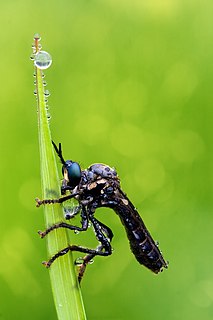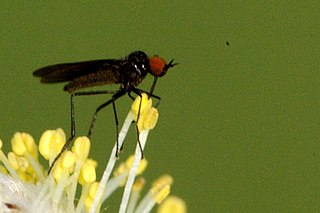
The Limoniinae are a paraphyletic assemblage of genera within the crane flies, Tipulidae, although they can usually be distinguished by the way the wings are held at rest. Limoniines usually hold/fold the wings along the back of the body, whereas other tipulids usually hold them out at right angles. Snow flies such as Chionea scita have no wings at all. Limoniines are also usually smaller than other tipulids, with some exceptions. Limoniinae are a very large assemblage with nearly 10500 described species in 133 genera, and were historically treated as a subfamily, but their classification is in flux; numerous authors recently treated the group at the rank of family, but subsequent phylogenetic analyses revealed that the remaining groups of tipulids render the group paraphyletic. These flies are found in damp places throughout the world, and many species form dense swarms in suitable habitats.

Tabanus bromius, sometimes called the band-eyed brown horsefly, is a species of biting horseflies.

The violet black-legged robber fly, Dioctria atricapilla, is a species of robber fly in the subfamily Dasypogoninae. This 9- to 12-millimeter long insect has a wingspan of roughly 7 to 9 mm and short, three-segmented antennae. It's a predatory insect, feeding mainly on smaller flies and predatory hymenopterans. It primarily thrives in grassland, and is seen from May to July.

Temnostoma bombylans is a species of hoverfly. Larva of this species feed in decaying wood of deciduous trees.

Phylidorea is a genus of crane flies in the family Limoniidae.

The Limnophilinae are a subfamily of tipulid crane flies. Some authors still use the name Hexatominae for this subfamily.

Rhamphomyia sulcata is a species of dance flies, in the fly family Empididae. It is included in the subgenus Rhamphomyia. It is found in most of Europe, except the Balkan Peninsula.

Rhamphomyia flava is a species of dance flies, in the fly family Empididae. It is found in most of Europe, except the Iberian Peninsula and most of the Balkan Peninsula.

Rhamphomyia nigripennis is a species of dance flies, in the fly family Empididae. It is found in most of Europe, except France, Italy, Croatia, Bosnia, Greece, Albania, Romania, Ukraine and Belarus

Rhamphomyia pilifer is a species of dance flies, in the fly family Empididae. It is found in most of Europe, except the Balkan Peninsula and the Iberian Peninsula.

Sargus flavipes, the yellow-legged centurion, is a European species of soldier fly.

Phylidorea ferruginea is a Palearctic species of craneflies in the family Limoniidae.It is found in a wide range of habitats and micro habitats: in earth rich in humus, in swamps and marshes, in leaf litter and in wet spots in woods.

Hybos culiciformis, common name dance fly, is a species of fly belonging to the family hybotid.

Opomyza florum, common name yellow cereal fly or grass fly, is a species of acalyptrate flies.

Sepedon sphegea is a Palearctic species of fly in the family Sciomyzidae, the marsh flies or snail-killing flies. The larva feeds on aquatic snails and as an opportunist on other invertebrates. The habitat of this species includes among many others, pond margins and damp meadows. It has a particular fondness for Iris pseudacorus which grow at the edges of the pond. Adults can be found all year long but the main flight period is from March to October.

Cetema elongatum is a species of fly in the family Chloropidae, the grass flies. It is found in the Palearctic. The larva feeds on Poaceae.

Rhamphomyia albohirta is a species of fly in the family Empididae. It is included in the subgenus Aclonempis. It is found in the Palearctic.

Rhamphomyia erythrophthalma is a species of fly in the family Empididae. It is found in the Palearctic.

Rhamphomyia stigmosa is a species of fly in the family Empididae. It is found in the Palearctic.

Neomochtherus geniculatus is a species of fly in the robber fly family, Asilidae.




















